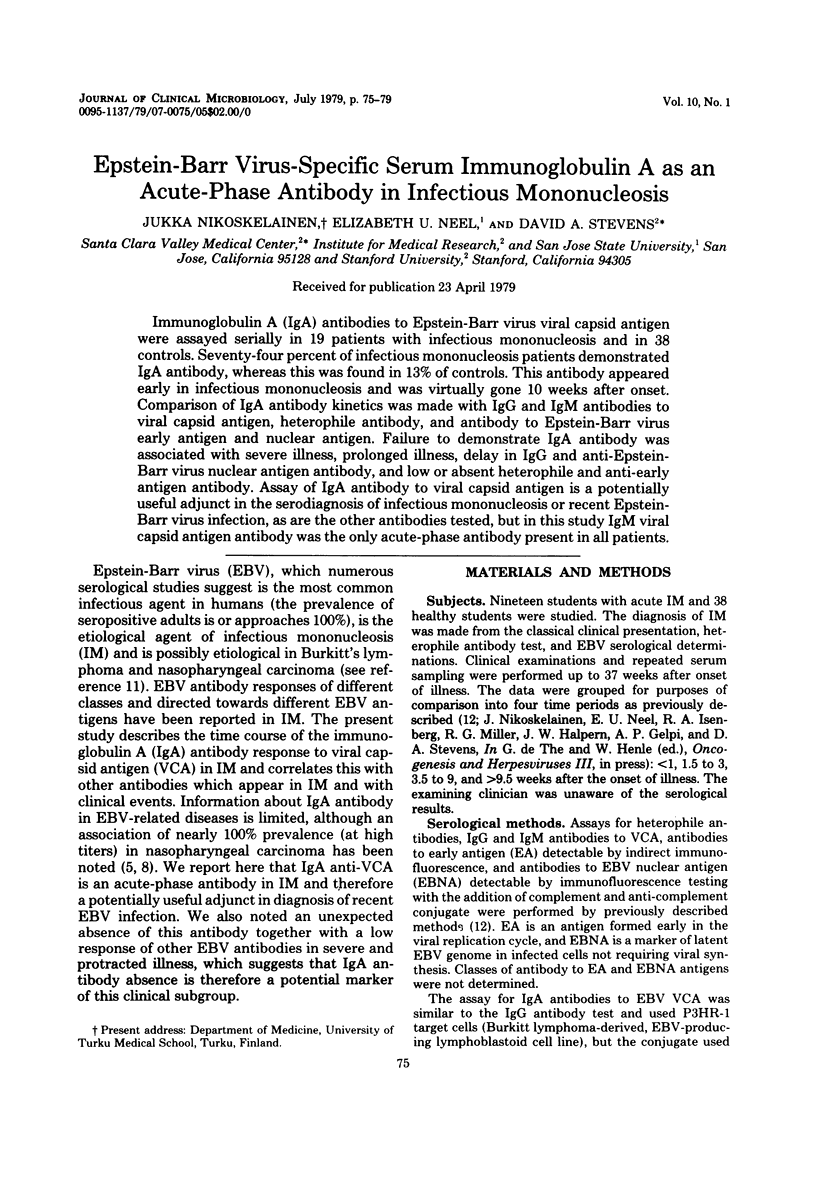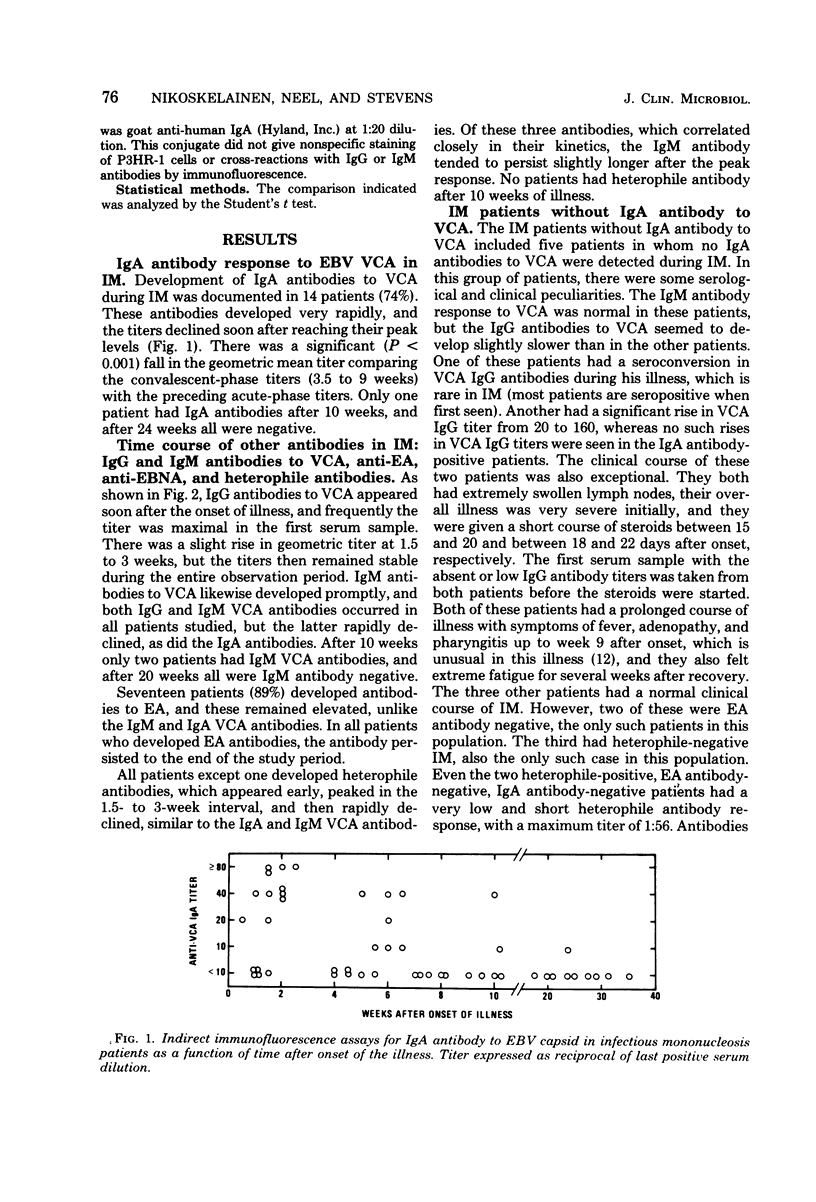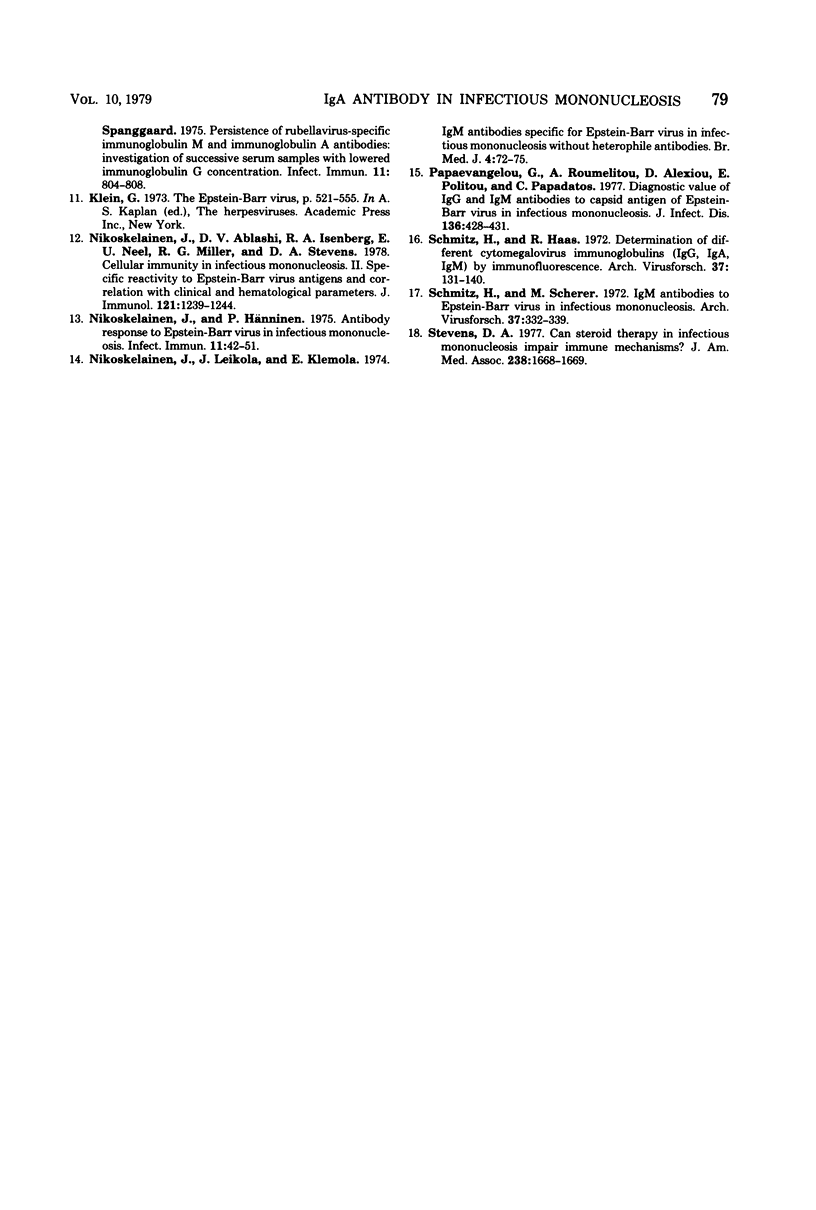Abstract
Immunoglobulin A (IgA) antibodies to Epstein-Barr virus viral capsid antigen were assayed serially in 19 patients with infectious mononucleosis and in 38 controls. Seventy-four percent of infectious mononucleosis patients demonstrated IgA antibody, whereas this was found in 13% of controls. This antibody appeared early in infectious mononucleosis and was virtually gone 10 weeks after onset. Comparison of IgA antibody kinetics was made with IgG and IgM antibodies to viral capsid antigen, heterophile antibody, and antibody to Epstein-Barr virus early antigen and nuclear antigen. Failure to demonstrate IgA antibody was associated with severe illness, prolonged illness, delay in IgG and anti-Epstein-Barr virus nuclear antigen antibody, and low or absent heterophile and anti-early antigen antibody. Assay of IgA antibody to viral capsid antigen is a potentially useful adjunct in the serodiagnosis of infectious mononucleosis or recent Epstein-Barr virus infection, as are the other antibodies tested, but in this study IgM viral capsid antigen antibody was the only acute-phase antibody present in all patients.
Full text
PDF




Selected References
These references are in PubMed. This may not be the complete list of references from this article.
- Al-Nakib W., Best J. M., Banatvala J. E. Rubella-specific serum and nasopharygeal immunoglobulin responses following naturally acquired and vaccine-induced infection. Prolonged persistence of virus-specific IgM. Lancet. 1975 Jan 25;1(7900):182–185. doi: 10.1016/s0140-6736(75)91356-2. [DOI] [PubMed] [Google Scholar]
- Edwards J. M., McSwiggan D. A. Studies on the diagnostic value of an immunofluorescence test for EB virus-specific IgM. J Clin Pathol. 1974 Aug;27(8):647–651. doi: 10.1136/jcp.27.8.647. [DOI] [PMC free article] [PubMed] [Google Scholar]
- Evans A. S., Niederman J. C., Cenabre L. C., West B., Richards V. A. A prospective evaluation of heterophile and Epstein-Barr virus-specific IgM antibody tests in clinical and subclinical infectious mononucleosis: Specificity and sensitivity of the tests and persistence of antibody. J Infect Dis. 1975 Nov;132(5):546–554. doi: 10.1093/infdis/132.5.546. [DOI] [PubMed] [Google Scholar]
- Henie G., Henle W., Horwitz C. A. Antibodies to Epstein-Barr virus-associated nuclear antigen in infectious mononucleosis. J Infect Dis. 1974 Sep;130(3):231–239. doi: 10.1093/infdis/130.3.231. [DOI] [PubMed] [Google Scholar]
- Henle G., Henle W. Epstein-Barr virus-specific IgA serum antibodies as an outstanding feature of nasopharyngeal carcinoma. Int J Cancer. 1976 Jan 15;17(1):1–7. doi: 10.1002/ijc.2910170102. [DOI] [PubMed] [Google Scholar]
- Henle W., Henle G., Niederman J. C., Klemola E., Haltia K. Antibodies to early antigens induced by Epstein-Barr virus in infectious mononucleosis. J Infect Dis. 1971 Jul;124(1):58–67. doi: 10.1093/infdis/124.1.58. [DOI] [PubMed] [Google Scholar]
- Ho H. C., Ng M. H., Kwan H. C., Chau J. C. Epstein-Barr-virus-specific IgA and IgG serum antibodies in nasopharyngeal carcinoma. Br J Cancer. 1976 Dec;34(6):655–660. doi: 10.1038/bjc.1976.228. [DOI] [PMC free article] [PubMed] [Google Scholar]
- Hornsleth A., Leerhoy J., Grauballe P., Spanggaard H. Persistence of rubellavirus-specific immunoglobulin M and immunoglobulin A antibodies: investigation of successive serum samples with lowered immunoglobulin G concentration. Infect Immun. 1975 Apr;11(4):804–808. doi: 10.1128/iai.11.4.804-808.1975. [DOI] [PMC free article] [PubMed] [Google Scholar]
- Nikoskelainen J., Ablashi D. V., Isenberg R. A., Neel E. U., Miller R. G., Stevens D. A. Cellular immunity in infectious mononucleosis. II. Specific reactivity to Epstein-Barr Virus antigens and correlation with clinical and hematologic parameters. J Immunol. 1978 Oct;121(4):1239–1244. [PubMed] [Google Scholar]
- Nikoskelainen J., Hänninen P. Antibody response to Epstein-Barr virus in infectious mononucleosis. Infect Immun. 1975 Jan;11(1):42–51. doi: 10.1128/iai.11.1.42-51.1975. [DOI] [PMC free article] [PubMed] [Google Scholar]
- Nikoskelainen J., Leikola J., Klemola E. IgM antibodies specific for Epstein-Barr virus in infectious mononucleosis without heterophil antibodies. Br Med J. 1974 Oct 12;4(5936):72–75. doi: 10.1136/bmj.4.5936.72. [DOI] [PMC free article] [PubMed] [Google Scholar]
- Papaevangelou G., Roumeliotou A., Alexiou D., Politou E., Papadatos C. Diagnostic value of IgG and IgM antibodies to capsid antigen of Epstein-Barr virus in infectious mononucleosis. J Infect Dis. 1977 Sep;136(3):428–431. doi: 10.1093/infdis/136.3.428. [DOI] [PubMed] [Google Scholar]
- Schmitz H., Haas R. Determination of different cytomegalovirus immunoglobulins (IgG, IgA, IgM) by immunofluorescence. Arch Gesamte Virusforsch. 1972;37(1):131–140. doi: 10.1007/BF01241158. [DOI] [PubMed] [Google Scholar]
- Schmitz H., Scherer M. IgM antibodies to Epstein-Barr virus in infectious mononucleosis. Arch Gesamte Virusforsch. 1972;37(4):332–339. doi: 10.1007/BF01241456. [DOI] [PubMed] [Google Scholar]


